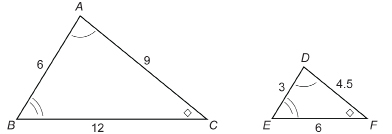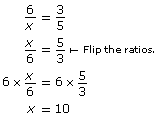Module 6
1. Module 6
1.12. Page 2
Module 6: Triangles and Other Polygons
Get Started
In this activity you will review the relationships among the corresponding sides and angles of similar triangles.
 Try This
Try This
Work with a partner, if possible.
TT 1. With your partner, identify at least three pairs of similar triangles in your surroundings.
Save your answer in your course folder, as you will be asked to copy your response into the Assignment Booklet later in the lesson.
TT 2. Consider the following two triangles.

The two triangles are similar. Write down the side ratios you could use to help prove the triangles are similar. What does the size of the ratio indicate about the two triangles?
TT 3. Take the side ratios you used in TT 2 and flip each fraction over. What do you notice about the new ratios? What does the size of the ratio tell you about the triangles?
Flipping Over
The previous example illustrates the important idea that flipping ratios can be used to help solve equations. The next example shows how useful flipping ratios can be.
Example 1
Solve ![]()
Solution
Many people prefer to see the variable in the numerator (on top of the fraction) rather than in the denominator, where the variable is in this case. Whenever you have a proportion (two equal ratios), you can flip the ratios in the equation.
So,

Check by substituting for x in the original equation. Check ![]() It works!
It works!
 Self-Check
Self-Check
Practise this technique. Solve each equation.
SC 1.
![]()
SC 2.
![]()
SC 3.
![]()